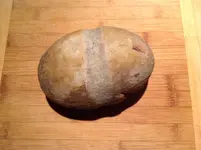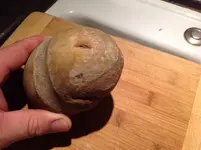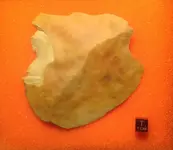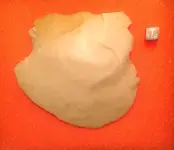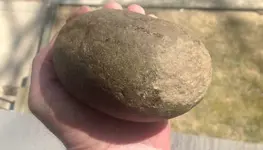Around here (Appalachian foothills) the groove would have developed a uniform patina to the rest of the piece by now. It looks too sharp and clean for us. Not sure where you are from. It just doesn't look authentic to me. A lack of heavy weathering may make the rule different where you are. I've seen what I know are modern fakes that look very similar to this piece.
Something that perhaps needs to be considered with regards to patina in this instance. The rock itself is a cobble. Except for the groove, that's all original skin or cortex. Allowing for any usage wear at the ends. But the thing to keep in mind is that the patina of the skin or cortex of the quartzite cobble could be 10's of thousands of years old, even hundreds of thousands years old. In other words, it could have existed as a cobble for far longer then there have even been humans in the Americas. So, it could take 10's of thousands of years for the patina in the groove to match the patina of the original cortex/skin on a cobble. Conversely, if the rock had been reduced so that no original skin remained, and then a groove, or notches, or whatever was worked in, one might expect the patina in a groove to match the patina where the stone was altered elsewhere. Here is an example of what I mean. A flaked semi lunar knife. The reddish area is original skin from a cobble that might have been exposed for tens of thousands of years. So, where it's flaked on one side, the patina will never attain the same appearance until ages have passed. This has to be kept in mind when you are comparing patina in a groove, or in flaking, that is far, far, far younger then the patina on skin that could be, frankly, even millions of years old. The tremendous potential age of original skin/cortex must be factored in when deciding if the patina in a groove cutting across that original skin looks "too fresh". It's not too fresh when the original patina on the cortex can be millions of years old. In the artifact below, the patina in the flaked area is not even close to matching the patina on the skin. But it is nonetheless patinated rhyolite. But we cannot expect the patina on the flaked portion to match patina that may be millions of years old on the original skin of the cobble itself. This artifact is just a spall of rhyolite detached from one end of a rhyolite cobble. On the side that is broken, you can see the same degree of patina as the area flaked on the side that shows the original skin of the cobble/ pebble.
Very long winded here, what else is new I guess, but want to get across that a groove does not look "too fresh", necessarily that is, if it's being contrasted to a patina on skin that may be literally millions of years old! When there is a huge difference in exposure age, this is to be expected, and does not necessarily mean the fresher patina is somehow "recent". It will be a different story with quarried stone, since that may be being exposed to the elements for the very first time when it is actually quarried. A cobble, in contrast, may have lay exposed to the elements for literally millions of years before a groove was pecked into it, or until one end was battered through use as a hammerstone.
As a final example, look at the patina on a hammerstone, where it was battered. Does it look the same as the skin of the cobble?? No. And that's because the skin has patina that could be millions of years old. It does not mean that the battering is somehow fresh. We are comparing patina on a surface battered hundreds or thousands of years ago to the cortex patina that may be millions of years old. Have to factor that fact in when comparing altered areas to completely unaltered skin/cortex! And one needs to factor that in with the grooved stone in this thread. Which does not mean it may not be recent/ modern, but what I am zeroing in on here needs to be factored in as well.....

